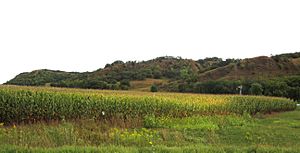List of National Natural Landmarks in Iowa facts for kids
Iowa is home to some truly special natural places, recognized as National Natural Landmarks. These landmarks are areas that show off the best examples of America's natural history. They are like living museums, protecting unique landforms, plants, animals, and geological features. There are 8 of these amazing spots right here in Iowa!
Contents
Iowa's Amazing Natural Landmarks
These special places help us understand how our Earth was formed and how nature works. They are protected so that everyone, including future generations, can enjoy and learn from them.
Anderson Goose Lake
Designated: 1975 Location: Iowa County Ownership: Private
Anderson Goose Lake is a rare and beautiful example of a "glacial pothole lake." Imagine a giant ice sheet, like a huge bulldozer, moving across the land thousands of years ago. As it melted, it left behind depressions in the ground that filled with water, creating these unique lakes. Anderson Goose Lake is one of the very few that remains in its natural state in Iowa. It's a great spot to see how the landscape looked after the last ice age.
Cayler Prairie
Designated: 1965 Location: Dickinson County Ownership: State
Cayler Prairie is a fantastic example of "virgin prairie grassland." This means it's never been plowed or developed by humans. Prairies are like natural grasslands, full of tall grasses and colorful wildflowers. They used to cover huge parts of the Midwest. Cayler Prairie shows us what these vast grasslands looked like before people settled the area. It's an important place for studying native plants and animals that depend on this special habitat.
Cold Water Cave
Designated: 1987 Location: Winneshiek County Ownership: Private
Deep underground in Iowa, you'll find Cold Water Cave. This cave is an incredible example of a large cave system. It's filled with amazing formations called "speleothems." These are the beautiful stalactites (hanging from the ceiling) and stalagmites (growing from the floor) that you often see in caves. They form over thousands of years as water drips and leaves behind minerals. Cold Water Cave is a natural wonder, showing the hidden beauty beneath Iowa's surface.
Dewey's Pasture and Smith's Slough
Designated: 1975 Location: Clay County, Palo Alto County Ownership: State
Just like Anderson Goose Lake, Dewey's Pasture and Smith's Slough are more examples of "pothole lakes." These lakes were also formed during the last ice age when glaciers carved out the land. They are important wetlands that provide homes for many different kinds of birds, fish, and other wildlife. These areas are vital for understanding the natural history of Iowa's wetlands.
Hayden Prairie
Designated: 1965 Location: Howard County Ownership: State
Hayden Prairie is another wonderful "true prairie remnant." Like Cayler Prairie, it's a piece of the original prairie that once covered Iowa. It's a living reminder of the state's natural heritage. These prairies are not just pretty; they are also very important for the environment. They help the soil stay healthy and provide homes for many unique plants and animals that can't live anywhere else.
Loess Hills
Designated: 1986 Location: Harrison County, Monona County Ownership: State, Private
The Loess Hills are truly unique! They are one of the best examples of "loess topography" in the world. "Loess" (pronounced "luss") is a special kind of fine, silty soil that was blown by strong winds after the glaciers melted. Over thousands of years, this wind-blown dust piled up to form steep, sharp ridges and valleys. The Loess Hills stretch along the Missouri River and are home to plants and animals found nowhere else in Iowa.
White Pine Hollow State Forest
Designated: 1967 Location: Dubuque County Ownership: State
White Pine Hollow State Forest is a very special place because it's the only known remaining "white pine tract" in Iowa. "White pines" are tall, majestic trees that were once common in some parts of the state. This forest is like a living fossil, showing us what Iowa's forests looked like long ago. It's a quiet and beautiful place, important for protecting these rare trees and the wildlife that lives among them.


